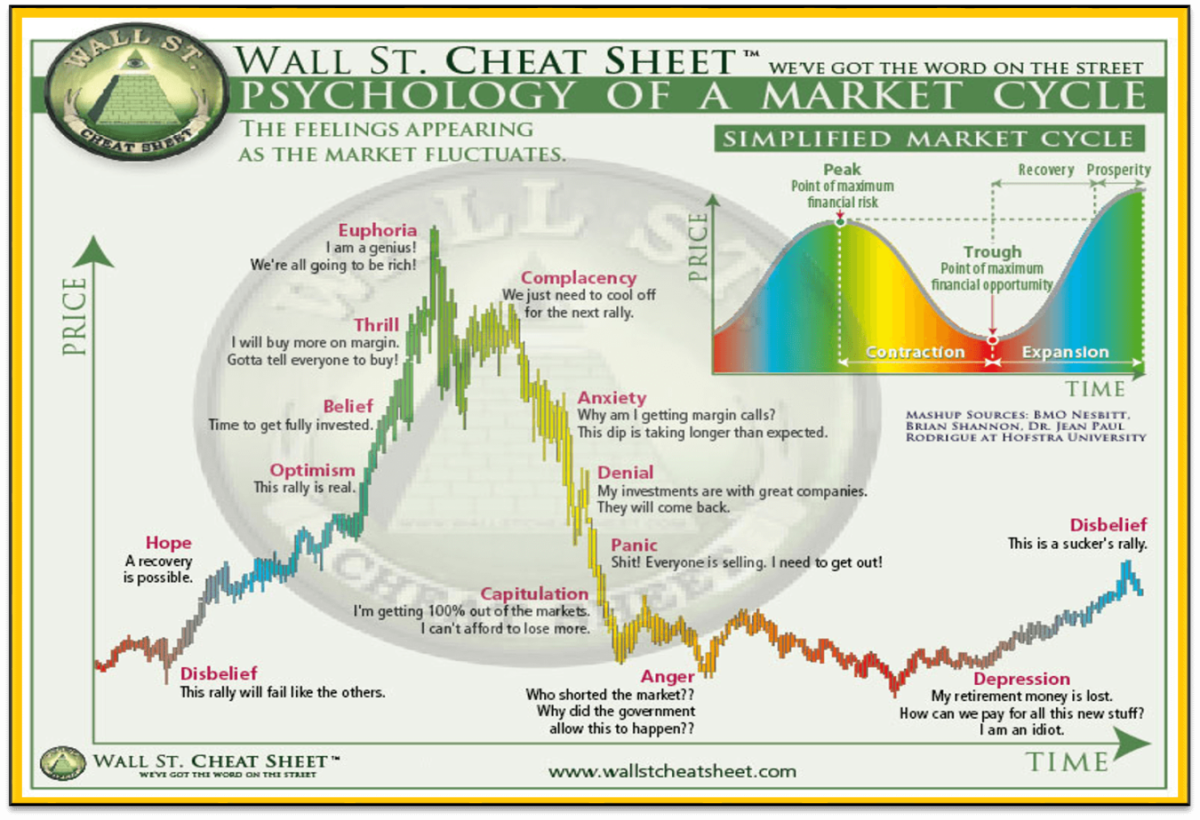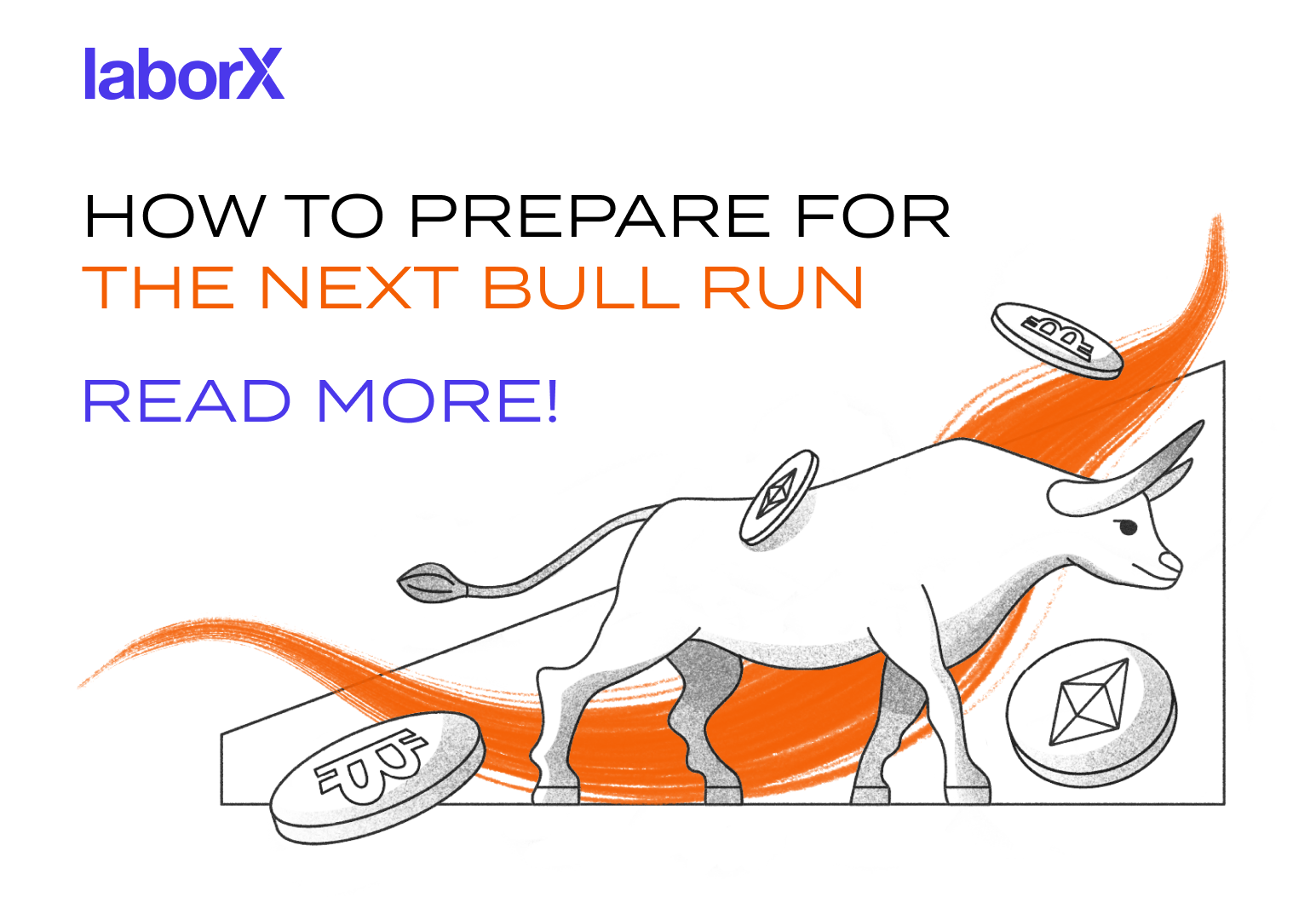As the market looks set to enter a new phase, a little preparation can mean you make the most of what might be about to happen.
The daily competition between buyers and sellers that determines the direction of the market is often described as a battle between bulls and bears, due to the characteristics of these animals. A rising market trend is known as a bull market, perhaps because bulls charge forwards, bringing their horns upwards to attack. In a bear market, prices fall over a prolonged period of time, possibly because bears attack by swiping their paws downwards.
Bitcoin (and more widely, crypto in general) has been on an uptrend for a year now, though many people still do not recognise this. As the bull market gets underway in earnest, and momentum picks up, more and more traders will realise that BTC is not going to drop back towards its lows. This becomes a self-fulfilling cycle, as optimism begets optimism and buyers drive the price – and confidence – still higher.
If you plan to invest in crypto, the only question is when in the cycle you will do so – and therefore whether you will buy, or sell, too late to benefit. The first step to profiting from the ongoing bull run is understanding the markets.
As ever, none of this is financial advice. The information in this article is provided for background only, since everyone’s circumstances and priorities will differ.
The Psychology Of A Market Cycle
Markets can seem complex and chaotic, but in some ways they’re very simple. What we call ‘the market’ is really just the aggregate of all the trading that takes place for a given asset. That, in turn, is driven by traders’ emotions. In general, people buy when they’re feeling positive about an asset, and sell when they’re feeling pessimistic.
That might be understandable, but listening to your emotions is completely the wrong way to go about trading. Getting caught up in that herd mentality is a good way to end up buying high and selling low. This is, in fact, what the majority of traders do. A report from trading platform eToro suggests that 80% of users lose money over a 12-month period. For short-term trading (e.g. day-trading) and high risk products and activities, that can be even higher.
Instead, buying at the right time often requires parking or going against your emotions, and making decisions that are logical but that may not feel right – something that is extremely difficult to do. As Warren Buffett put it, ‘be fearful when others are greedy and be greedy when others are fearful’. In other words, be a contrarian. Go against the herd.
The Wall Street Cheat Sheet is a popular chart that describes a typical market cycle in terms of the emotions experienced by the majority of investors. While it’s a simplified overview, it’s surprisingly accurate when compared to bitcoin and other market cycles. The reason is that, although circumstances may vary, human psychology remains the same.

At the beginning of the bull market, prices are increasing and investors feel confident. It’s a time of optimism, where traders are excited at the opportunities they see. As prices rise further, more buyers come in as the belief that the uptrend is real and has legs becomes stronger.
As the bubble peaks, belief turns to thrill and traders become irrationally exuberant. FOMO prompts them to put in more money, even borrowing (buying with leverage) to acquire more. The very peak is marked by euphoria, as greed completely takes over and large numbers of traders buy the top, believing that prices will continue to rise and they can’t lose. Of course, when everyone has bought and there are no more new buyers, that’s where reality sets in.
The first dip might come as a shock, but there’s typically a bounce, giving rise to complacency that it was just a temporary blip on the road to higher prices. As the downtrend gets underway, though, anxiety sets in – but many traders will continue to hold, hoping that it’s just another temporary drop. Denial comes next, since having invested so much (emotionally and financially), it’s hard to admit they were wrong. But that turns to panic when traders realise that everyone else is selling, and they’re continuing to lose money by keeping their faith. Mass-selling only accelerates the process, which culminates in capitulation, as investors are overwhelmed by fear. Many sell their investments at a loss. This is the point of maximum pessimism.
This is typically followed by a period of consolidation at lower prices, which may be accompanied by anger – directed at other traders, regulators, the government, companies – any convenient scapegoat, and then depression.
At the end of the bear market, almost no one has any faith in the asset any more. Any initial price rise is viewed with disbelief and skepticism, rather than hope – which only comes later. Finally, traders slowly start to accept the possibility that the asset has a future after all, and the cycle repeats.
The Wall Street Cheat Sheet is a simple but insightful guide that highlights the role that mass psychology plays in the market cycle. To be successful, it’s absolutely vital to be aware of these stages, and to maintain a degree of separation from your own emotions. By recognising the patterns that appear time and again, in every cycle, you can avoid the problems that plague most retail traders and buy at the lows, rather than the highs.
Take the last bitcoin bear market, for example. When BTC bottomed out at $15,500, few people were bullish. Despair characterised the crypto space. And yet this was exactly the right time to buy – just as the $69,000 bubble top, characterised by peak optimism, was the right time to sell.
Unfortunately, most people will be caught out this time too, and will buy and sell at the wrong points. By understanding the market cycle better, and by making a plan, you can avoid making the same mistake.
The Bull Market Is Under Way
There are lots of opinions about whether crypto is in a new bull market, or whether the recent price rise is still part of the bear market – a ‘reaction rally’, or ‘bear market rally’. Data speaks loudest, though, and the technical indicators are good.
Bitcoin has been putting in a series of higher highs and higher lows for the last year, since the bear market low in November 2022. Since then, BTC has more than doubled in price, from the $15,500 bottom to a high close to $36,000.
Towards the end of October, it decisively broke through the $30-32k zone, which has been a key support/resistance area stretching back almost three years. BTC is trading well above both the 200-day moving average and the 200-week MA, both key lines that traders watch for confirmation. Bitcoin Dominance – the percentage of the total crypto market that bitcoin accounts for – has been trending upwards.
While there are never any guarantees, and it’s always possible that we’ll see a breakdown, all of these suggest that BTC is well into a new bull market – though the most decisive and impressive phase is yet to begin. In terms of the Wall Street Cheat Sheet, we’re moving into the hope stage.
ETF Anticipation
Moreover, there’s a compelling new narrative for this cycle, as BTC is set to become a mainstream asset, positioned as a hedge to traditional assets at a time of geopolitical uncertainty and high inflation.
Earlier this year, BlackRock filed an application with the SEC (the US securities regulator) to launch a spot BTC ETF, which would enable institutions and regular investors to gain direct exposure to BTC within conventional regulatory frameworks and existing trading platforms. BlackRock was followed by several other major financial institutions, which together manage trillions of dollars of customers’ money, opening the possibility of a wave of new cash entering the space in the near future.
Various organisations have tried to launch spot BTC ETFs before, but have always been refused by the SEC, which has been extremely hostile towards crypto. However, the regulator is now on the back foot following a series of legal defeats by crypto companies, including Ripple and Grayscale. Sentiment is shifting against it. There is widespread anticipation that one or more ETFs will be approved by January 2024.
The Halving
Another factor that suggests the bull run is under way is that Bitcoin’s Halving is now just five months away. This event, which is hard-coded into the Bitcoin protocol, will see the block rewards paid to miners decrease from 6.25 BTC to 3.125 BTC every 10 minutes. The reduction in new supply is keenly awaited by traders, since – all things being equal – it means higher prices will be required to accommodate the same demand. This Halving event will reduce Bitcoin’s ‘inflation’ down to 1% or less – making it the hardest money on the planet.
Interest Rates
Finally, in the US – the world’s largest economy – there are signals that interest rates have peaked, and the dollar may weaken in the coming months. This would encourage money to flow into risk assets like stocks and crypto, giving a further tailwind to the bull market.
Opportunities And Risks
There are huge opportunities presented by crypto bull markets, in which assets can increase in value by 10-100x, or even more. There are also significant risks, if you get caught on the wrong side of a trade, or fall for a scam.
Timing the market is difficult, even for professional traders. Dollar-cost averaging is one way to build a position over time, while reducing risk. However, that’s not such a good idea if the market is rapidly rising, in the final stage of the bull market. If that’s the case, your average price will increase with every buy, and you’ll likely miss the opportunity to profit because you won’t have time to deploy enough capital. (Fortunately, we’re not there yet, so there’s still time to prepare.)
If you don’t have disposable income to invest in crypto, the alternative is to work for it. This is a good option if you have transferable skills that can be put to use in the Web3 sector.
As confidence returns to the crypto world, so do money and ideas. New projects will be launched every day. Some will be successful, and will become well-established in the blockchain space for years to come. Others will try but fail and fade away.
Many of these projects will be looking for employees of one kind or another, so as a Web3 freelancer your skills will be in demand. That’s true across all areas: blockchain developers and smart contract coders, UI/UX experts, marketing professionals, graphic designers, copywriters and content creators, legal advisors, traders… the list goes on. If you already work in the tech sector, there’s a good chance you’ll be able to find a job in the blockchain arena.
The rising tide of an uptrend in the crypto markets is therefore a great time to use platforms like LaborX to pick up some freelance work and earn crypto. Whether you’re just looking for short, one-off gigs to earn some coins in your spare time, or for longer-term (even full-time) opportunities and a whole new career in Web3, there will be listings that are suitable for you.
Finally, be aware that there are dark sides to a bull market. Aside from the temptations of YOLO and FOMO, and the risk of buying the top, this stage of the cycle typically sees an increase in activity from scammers and hackers, who will try every way they can to separate users from their crypto. Learning to spot the most solid and promising projects, and avoiding the scams, is a skill in itself. In general, though, learn all you can about security and managing your own wallets, rather than trusting third parties. Be wary of projects that promise the moon. And always do your due diligence before you transfer any funds.





